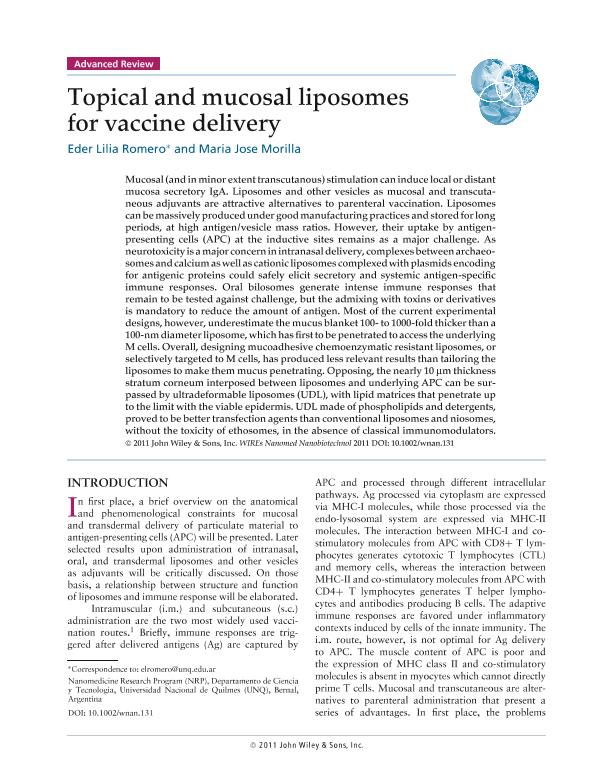Artículo
Topical and mucosal liposomes for vaccine delivery
Fecha de publicación:
02/2011
Editorial:
John Wiley & Sons
Revista:
Wiley Interdisciplinary Reviews: Nanomedicine and Nanobiotechnology
ISSN:
1939-5116
Idioma:
Inglés
Tipo de recurso:
Artículo publicado
Clasificación temática:
Resumen
Mucosal (and in minor extent transcutanous) stimulation can induce local or distant mucosa secretory IgA. Liposomes and other vesicles as mucosal and transcutaneous adjuvants are attractive alternatives to parenteral vaccination. Liposomes can be massively produced under good manufacturing practices and stored for long periods, at high antigen/vesicle mass ratios. However, their uptake by antigen-presenting cells (APC) at the inductive sites remains as a major challenge. As neurotoxicity is a major concern in intranasal delivery, complexes between archaeosomes and calcium as well as cationic liposomes complexed with plasmids encoding for antigenic proteins could safely elicit secretory and systemic antigen-specific immune responses. Oral bilosomes generate intense immune responses that remain to be tested against challenge, but the admixing with toxins or derivatives is mandatory to reduce the amount of antigen. Most of the current experimental designs, however, underestimate the mucus blanket 100- to 1000-fold thicker than a 100-nm diameter liposome, which has first to be penetrated to access the underlying M cells. Overall, designing mucoadhesive chemoenzymatic resistant liposomes, or selectively targeted to M cells, has produced less relevant results than tailoring the liposomes to make them mucus penetrating. Opposing, the nearly 10 μm thickness stratum corneum interposed between liposomes and underlying APC can be surpassed by ultradeformable liposomes (UDL), with lipid matrices that penetrate up to the limit with the viable epidermis. UDL made of phospholipids and detergents, proved to be better transfection agents than conventional liposomes and niosomes, without the toxicity of ethosomes, in the absence of classical immunomodulators.
Palabras clave:
TOPICAL
,
MUCOSAL
,
IMMUNIZATION
,
LIPOSOMES
Archivos asociados
Licencia
Identificadores
Colecciones
Articulos(SEDE CENTRAL)
Articulos de SEDE CENTRAL
Articulos de SEDE CENTRAL
Citación
Romero, Eder Lilia; Morilla, María José; Topical and mucosal liposomes for vaccine delivery; John Wiley & Sons; Wiley Interdisciplinary Reviews: Nanomedicine and Nanobiotechnology; 3; 4; 2-2011; 356-375
Compartir
Altmétricas




